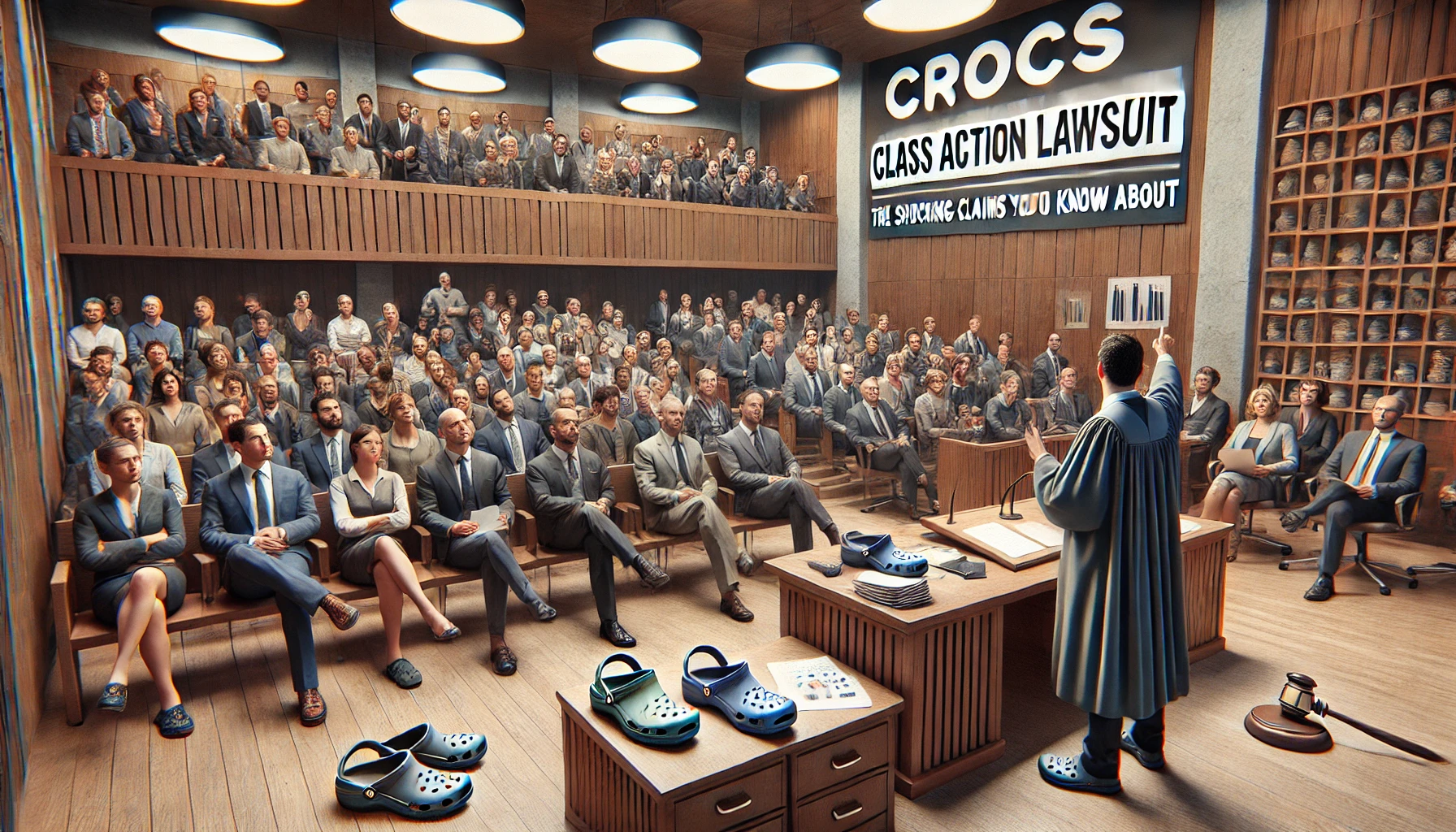Introduction
Shocking Waves in the World of Footwear! Picture this: a single lawsuit that ripples across the globe, challenging how a footwear giant like Crocs handles its business. This isn’t just any legal battle—it’s a class action lawsuit, where individual voices unite to take on a powerhouse.
What’s a Class Action Lawsuit Anyway?
Imagine you and a bunch of friends have the same complaint against a big company. Instead of fighting alone, you all come together to file one mega lawsuit. That’s a class action—multiple people joining forces to tackle common legal grievances, aiming for a resolution that benefits everyone involved. This kind of lawsuit is a game-changer, especially when it involves a well-known company like Crocs, known for its unique and widely popular footwear.
Background of Crocs
From Humble Beginnings to Global Sensation:
Crocs, Inc. started with a simple yet revolutionary idea: to create a shoe that was both comfortable and versatile. Launched in 2002, these distinctive shoes quickly transitioned from a boating shoe to a global phenomenon, thanks to their proprietary Croslite material—a soft, lightweight, and odor-resistant plastic that conforms to the wearer’s feet. Key milestones include their explosive popularity in the mid-2000s and their strategic expansions into over 90 countries, making Crocs a household name.
Why Crocs? Comfort Meets Versatility:
Crocs are celebrated for their unmatched comfort, making them a top choice for casual wear and professional use alike. They are particularly favored in healthcare, culinary, and other industries where long hours on feet are the norm. The brand’s ability to blend functionality with style has also led to various high-profile collaborations and limited-edition releases, further cementing Crocs as a staple in diverse wardrobes around the world.
Origins of the Lawsuit
A Timeline of Discontent:
The class action lawsuit against Crocs, Inc. was initiated in early 2021 after numerous consumers raised concerns over alleged false advertising and safety issues related to the footwear. The complaints primarily centered around the claims made by Crocs about the slip-resistant properties of their shoes, which plaintiffs argued were misleading. This led to a series of legal challenges as affected consumers began to band together to seek redress for what they perceived as deceptive marketing practices.
Key Players at the Legal Front:
The plaintiffs in this case comprise a diverse group of individuals from various states who claim to have suffered slips, falls, and injuries due to the purportedly misleading safety features of Crocs shoes. Representing a collective grievance, these individuals have come forward with similar allegations, seeking accountability from a single defendant—Crocs, Inc. This renowned footwear company, known for its innovative designs and claims of superior comfort and safety, now faces serious accusations that challenge the core attributes of its product offerings.
Specific Allegations
Core Complaints Against Comfort Claims:
The plaintiffs have levied several serious allegations against Crocs, Inc. Central to these claims is the assertion that Crocs misrepresented the slip-resistant capabilities of their footwear. Despite being marketed as suitable for various work environments where slip resistance is critical—like hospitals and kitchens—plaintiffs allege that the shoes failed to deliver on these safety promises, leading to accidents and injuries.
Voices from the Court Documents:
Legal documents filed in the case highlight the gravity of the claims. One statement from the plaintiffs reads, “Crocs, Inc. advertised their products as ‘slip-resistant’ which led consumers to believe in the safety of wearing such footwear under conditions where slipping could be hazardous. However, numerous incidents have demonstrated that these shoes do not perform as advertised, resulting in a false sense of security and, tragically, injuries.” This statement underscores the disparity between the marketed qualities of Crocs and the alleged real-world experiences of the consumers.
Kennedy Funding Lawsuit: The High-Stakes Legal Battle Uncovered
Legal Grounds for the Lawsuit
Foundations of the Legal Challenge:
The lawsuit against Crocs, Inc. is primarily based on allegations of false advertising and consumer fraud. These claims are supported by various consumer protection laws that are designed to safeguard buyers from misleading marketing practices. Specifically, the plaintiffs invoke statutes related to deceptive trade practices, which prohibit companies from making unfounded claims about the safety or functionality of their products. Legal precedents in similar cases often involve substantial financial penalties and mandates for corrective advertising practices, suggesting potential paths the court might take.
Plaintiffs’ Demands:
The group of plaintiffs in this lawsuit has outlined clear demands from Crocs, Inc. Their primary request is for financial compensation for damages resulting from the alleged false advertising—this includes personal injuries, lost wages, and medical expenses incurred due to the purportedly misleading slip-resistant claims. Additionally, they are seeking a court order that would require Crocs to change their marketing strategies and possibly retract their previous claims about the slip-resistance of their footwear to prevent future consumer deception.
Impact on Consumers
Personal Stories at the Forefront:
The lawsuit has brought to light numerous personal stories that illustrate the potential dangers associated with the footwear in question. One poignant example involves a healthcare worker from Florida who experienced a fall while wearing Crocs in a hospital setting—a place where slip-resistant footwear is critical. According to her testimony, “I trusted the safety features advertised by Crocs, but during a routine shift, I slipped and suffered a severe ankle injury that kept me out of work for weeks.” Such testimonials not only highlight individual suffering but also underscore the perceived breach of trust between the consumers and the brand.
Broader Consumer Implications:
The allegations against Crocs have stirred considerable concern among current and potential consumers. Many are re-evaluating the safety features of Crocs, especially those who rely on these shoes for work in environments where non-slip footwear is essential. The lawsuit could lead to increased consumer vigilance regarding product claims and more stringent scrutiny of advertising practices across the footwear industry. This case also serves as a reminder of the importance of verifying marketing claims, potentially prompting consumers to seek additional information or opt for products with certified safety standards.
Company’s Response
Official Stance of Crocs, Inc.:
In response to the lawsuit, Crocs, Inc. has firmly denied any wrongdoing. The company maintains that their marketing and product descriptions concerning the slip-resistance of their footwear are based on rigorous testing and comply with industry standards. Their official statement emphasizes, “Crocs are designed with the utmost care and advanced technology to ensure safety and comfort. We stand by the integrity of our products and will vigorously defend against these claims.”
Public Relations Moves:
In an effort to mitigate the impact of the lawsuit on their public image, Crocs has taken several proactive steps. They have published detailed results of their internal tests on the slip-resistant properties of their shoes on their website and through press releases. Additionally, the company has initiated a customer outreach program to directly address consumer concerns, offering additional information and resources about the safety features of their footwear.
Analysis of Legal Experts
Expert Predictions on Outcomes:
Legal experts are closely watching the Crocs lawsuit as it could set a precedent for future consumer safety claims against manufacturers. According to a seasoned litigator specializing in consumer rights, “The outcome of this case could hinge on the demonstrable evidence of safety claims made by Crocs and their adherence to advertising standards. If found liable, Crocs might face significant financial penalties and be required to overhaul their marketing practices.” Experts suggest that a settlement is also a strong possibility, which could involve Crocs agreeing to financial compensation without admitting fault, alongside commitments to modify their marketing strategies.
Historical Context and Similar Cases:
Looking at similar cases provides valuable insights. For instance, a case involving Sketchers in 2012, where the company faced charges of deceptive advertising over their Shape-ups shoes’ supposed health benefits, resulted in a $40 million settlement. Like Crocs, Sketchers had to reevaluate its marketing claims and compensate consumers. These historical precedents underscore the potential financial and reputational risks for companies embroiled in consumer litigation over product claims.
A Federal Judge Has Dismissed Blakeman’s Lawsuit Against the State: What It Means
Potential Consequences for Crocs
Financial Repercussions:
The financial impact on Crocs from this lawsuit could be substantial. Depending on the court’s findings, Crocs might face significant fines or be required to pay hefty settlement amounts to the plaintiffs. Such financial burdens often include not only direct compensation for the claimants but also legal fees and increased insurance premiums. If the lawsuit results in a verdict against Crocs, it could also necessitate the allocation of additional resources to ensure compliance and oversight in future marketing and product safety testing.
Impact on Brand Image and Customer Loyalty:
Beyond the financial implications, the class action lawsuit poses a serious risk to Crocs’ brand image. The allegations of misleading safety claims could erode consumer trust, a cornerstone of brand loyalty. This is particularly critical for a company like Crocs, whose brand is built on the perceived comfort and safety of its products. A damaged reputation might lead to a decline in sales and could affect partnerships and deals, particularly those in industries like healthcare, where reliability is paramount. Moreover, restoring public confidence would require significant marketing efforts and potentially a rebranding strategy to shift public perception positively.
Conclusion
Key Points Recap:
This deep dive into the Crocs class action lawsuit has uncovered the major allegations of misleading safety claims and the significant legal, financial, and reputational stakes for Crocs, Inc. The lawsuit emphasizes the critical nature of truthful advertising and the potentially severe consequences of betraying consumer trust, particularly in products marketed for their safety features.
Engage and Share:
We’d love to hear your thoughts or personal experiences related to Crocs or similar legal cases. Feel free to share your stories in the comments below or spread the word by sharing this article with others who might find it informative or relevant. Your input helps deepen the discussion and spread awareness about consumer rights and corporate accountability.
FAQs
Is there a lawsuit against Crocs?
Yes, there is an ongoing class action lawsuit against Crocs, Inc., primarily concerning allegations that the company falsely advertised the slip-resistant properties of their footwear.
Why did one of my Crocs shrink?
Crocs can shrink when exposed to high temperatures for prolonged periods, such as in direct sunlight or a hot car, because they are made of a resin material that responds to heat.
What is the lawsuit between Joybees and Crocs?
The lawsuit between Joybees and Crocs involves intellectual property disputes, with Crocs alleging that Joybees infringed on its design patents related to their iconic clogs.
Did Crocs almost go out of business?
Crocs faced significant financial challenges during the late 2000s due to rapid expansion and the economic downturn, but it managed to recover and remains a successful enterprise.
Why is Crocs closing?
If referring to store closures, Crocs has closed certain locations as part of its strategic realignment towards digital platforms and reducing its physical retail footprint, not because the company is going out of business.
Why do gyms not allow Crocs?
Many gyms do not allow Crocs because they typically lack the necessary support and grip for safe use during many forms of exercise, posing a risk of injury.
Explore the Laws realm with The Expert Law. Visit our website for limitless inspiration!





